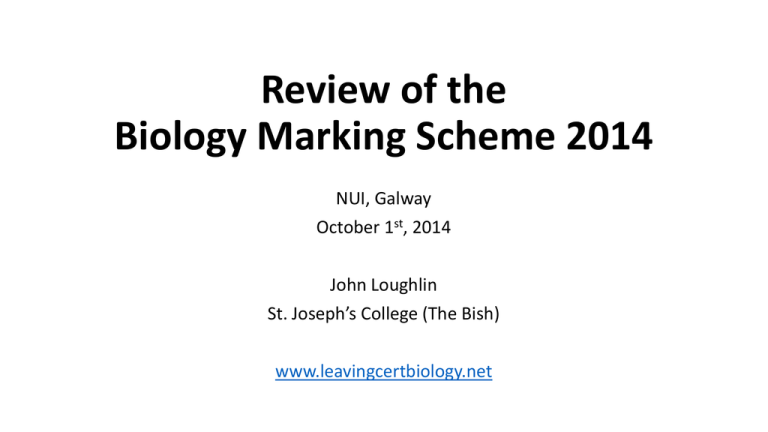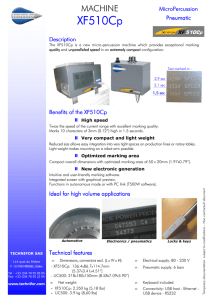
Review of the
Biology Marking Scheme 2014
NUI, Galway
October 1st, 2014
John Loughlin
St. Joseph’s College (The Bish)
www.leavingcertbiology.net
Basic rules followed by examiners
• Scheme is not exhaustive – other valid answers can be accepted
• Candidates’ answers must be in the correct context
• Cancelled answers are only considered cancelled if replaced with
another answer
• Section A involves cancelling – surplus incorrect answers cancel
correct answers
• Surplus incorrect answers in section B and C will only cause loss of
marks where a specific word/phrase is required, indicated by an *
Question 1 - Ecology
1. From your knowledge of ecology explain any five of the following terms:
(a) Biosphere. _______________________________________________
(b) Niche. __________________________________________________
(c) Biotic factor. _____________________________________________
(d) Trophic level. ____________________________________________
(e) Competition. _____________________________________________
(f) Symbiosis. _______________________________________________
Q1 Marking scheme
2(7) + 3(2) i.e. best five answers from (a) – (f)
(a) Biosphere
Parts of the earth or planet where life (or organisms)
exists – ‘ecosystem’ ‘habitat’ not allowed
(b) Niche
The (functional) role of an organism or a role explained
(c) Biotic factor A living factor (in an ecosystem)
(d) Trophic level Feeding level or stage or energy level or position in food
chain or position in pyramid of numbers
(e) Competition The struggle or fight/contest/strive for a resource (or
named resource)
(f) Symbiosis
Relationship or close association between two species
involving benefit (‘…between two organisms’ not allowed)
Question 2(a) – Food/nutrition
2.
(a)
The following biochemical reactions took place in some living cells:
(i) A
B+C+D
Is this an example of anabolism or catabolism?
______________________________________________
X
Fat
Fatty Acids + Y
Identify X and Y.
X . __________________ Y . ______________________
(i) How does a phospholipid differ from a fat?
Phospholipid: _______________________________________
Fat: _______________________________________________
(ii) Name a fat-soluble vitamin. ____________________________
(iii) State a disorder due to a dietary deficiency of the vitamin referred to in (b) (ii).
________________________
(iv) Give any two functions of minerals in organisms.
1. _____________________________________________
2. _____________________________________________
(ii)
(b)
Q2 Marking Scheme
7 + 6 + 7(1)
(a) (i) Catabolism
(ii) X = lipase, Y = glycerol
(b) (i) (A phospholipid) has a phosphate or P or phosphorus or (a phospholipid) has
two fatty acids
(A fat) has three fatty acids – ‘does not have a phosphate’ not allowed
(ii) A, D, E, or K (accept names of vitamins)
(iii) Matching disorder
Vitamin
Deficiency disorder
(iv) Formation of rigid structure (or
named) / formation of soft tissue
A
Night blindness, dry skin
(or named) / formation of fluid (or
named) / formation of pigment
D
Rickets, osteoporosis, osteomalacia
(or named) / biochemical function
E
Muscle weakness, dry hair, anaemia
of a named mineral /any other
specific function(s) of named
K
Poor blood clotting
mineral(s)
Question 3 – Circulatory and lymphatic systems
3. The diagram shows a region of tissue that includes body cells and parts of the circulatory and lymphatic
systems.
(a) Name part C. __________________________________________________________
(b) What type of blood vessel is A? ___________________________________________
(c) If a transverse section of A were viewed under the microscope state one way in which it would differ
from a transverse section through B. ______________________________________________________
(d) Give two functions of the lymphatic system.
1. ___________________________________________
2. ___________________________________________
(e) Give one way in which lymph differs from blood. _________________________________
(f) Name a major blood vessel that returns the blood in B to the heart. ____________________
Q3 Marking Scheme
8 + 7 + 5(1)
(a) C = Lymph vessel
(b) Arteriole [accept artery] No marks for named artery
(c) Narrow(er) lumen or thick(er) wall or no valves
(d) Maintains a constant level of ECF or drains fluid or returns fluid to blood /
manufacture of lymphocytes or maturation of lymphocytes
(manufacture/maturation of white blood cells not allowed)/ filtering bacteria
/ fighting infection / transport of named material (e.g. hormones, antibodies,
lipids) – ‘absorption of fats/lipids’ not allowed
(e) No red blood cells or no haemoglobin / no platelets / no clotting (proteins) /
higher fat level [accept correct colour difference] – note that both colours had
to be given
(f) Vena cava OR pulmonary vein
Question 4 – Classification of living organisms
4. (a) The living world may be divided into five kingdoms: Monera; Protista;
Fungi; Plantae; Animalia. In the case of each of the following pairs of
kingdoms give any structural feature of members of the first-named
kingdom not found in members of the second kingdom.
(i) Fungi and Animalia. ________________________________________
(ii) Plantae and Fungi. _________________________________________
(iii)Animalia and Monera. ______________________________________
(iv)Protista and Animalia. _______________________________________
(b) In each of the following cases, name an organism that fits the description.
(i) A multicellular fungus. ______________________________________
(ii) A member of the Protista that catches and consumes smaller
organisms. ________________________________________________
(iii)A harmful member of the Monera. ____________________________
Q4 Marking Scheme
8 + 7 + 5(1)
(a)
(i)
Cell wall or hypha (or named hypha) or mycelium or named reproductive
structure
(ii) Chloroplast or cellulose cell wall or named anatomical feature – e.g. vascular bundles,
leaf, petal, etc.
(iii) Nucleus or mitochondrion or multicellular or eukaryotic or nervous system or
digestive system or reproductive system or muscular system
(skeletal/respiratory/circulatory/excretory systems not allowed)
(iv) (Can be) unicellular or (can have) chloroplast or pseudopodia or contractile vacuole or
food vacuole or ‘false foot/feet’
(b)
(i)
Rhizopus (or bread mould) or other named fungus – e.g. mushroom
(ii) Amoeba
(iii) Any named (harmful) bacterium or named (harmful) effect of a bacterium [NB The
word ‘bacterium’ is essential if effect given] – e.g. E. coli, Tuberculosis bacteria
Q5 – Mitosis/Meiosis & Marking Scheme
5. Indicate whether the following statements are true (T) or false (F) by placing a
tick () in the appropriate box in each case.
T
(a) Single-celled organisms use meiosis for asexual reproduction.
(b) In telophase of mitosis, a cleavage furrow forms in plant cells.
(c) When a cell is not dividing it is said to be in prophase.
(d) The nuclear membrane disappears in the early part of mitosis.
(e) Centromeres give rise to the nuclear spindle.
(f) Mitosis is a source of variation.
(g) In multicellular organisms mitosis is primarily used for growth.
F
8
7
1
1
1
1
1
Question 6 - Respiration
(a) Suggest an advantage of using ATP as an energy store in cells. ____________________
(b) Name two processes requiring ATP that occur in cells.
________________________________________________
________________________________________________
(c)
Name two substances, other than carbon dioxide, into which pyruvate may be broken
down under anaerobic conditions in cells.
________________________________________________
________________________________________________
(d) What is the name of the two-carbon compound into which pyruvate is broken down
under aerobic conditions? _______________________________________________
(e) Briefly describe the fate, under aerobic conditions, of the two-carbon compound
referred to in part (d). ___________________________________________________
Q6 – Marking Scheme
8 + 7 + 5(1)
(a) High-energy molecule (or bond or compound) or easily (or quickly)
broken down or easily re-formed or reusable or energy easily releasedor
recyclable
(b) Any two named cell processes e.g. (photo)synthesis, respiration (or
named stages of these), (active) transport mitosis (or named phase of
mitosis) or meiosis
Digestion or cell division or growth not allowed
(c) 1.Lactic Acid
2.Ethanol [accept alcohol] or formula
(d) Acetyl (Co-enzyme A)
(e) Enters Krebs Cycle (or explained) or (broken down) to CO2 and H2O (H+ or
protons is acceptable too in place of H2O)
Question 7 – Seed germination
(a) (i) Name a part of a seed in which food for germination is stored. _______________
(ii) Name the three factors necessary for seeds to germinate.
1. ____________ 2. _____________ 3. _____________
(b) Answer the following questions on seed germination.
(i) At the start of the investigation to show digestive activity during germination the
seeds were sterilised.
1. Why is this necessary? ___________________________
2. How did you sterilise the seeds? ___________________
(ii) Name the substance that is used as a medium on which to germinate the seeds.
_________________________
(iii) What substance, to be digested by the seeds, was added to the above medium?
__________________________
(iv) What control did you use in this demonstration? ____________________
(v) How did you demonstrate that digestive activity had taken place? ____________
_________________________________________________________________
Q7 – Marking Scheme
(a) (i) *Cotyledon or *endosperm
3
(ii) Water / oxygen / suitable or correct temperature (or warmth) –
heat/temperature alone not allowed
3(1)
(b) (i) 1. To kill (or inhibit) any microorganisms (or bacteria and fungi)
3
2. Disinfectant or named disinfectant (washing up liquid not allowed)
3
(ii) Agar
3
(iii) Starch or milk or protein
3
(iv) (Same set-up and procedure with) boiled seeds accept ‘dead seeds’
3
(v) Iodine (or biuret) (solution) / negative result (or described) beneath or
around seeds / indicates the absence of (or digestion of) starch (or protein)
– result of control not allowed marks
3(3)
Must
match
Question 8 – Microscope and viewing animal cells
(a) Answer the following questions with reference to the microscope.
(i) State the function of the part labelled A in the diagram.
______________________
(ii) Lens E is marked 10× and lens O is marked 40×. A cell is
viewed through lenses E and O. The image of the cell is
0.8 mm in diameter. What is the actual diameter of the
cell? _____________
(b) Answer the following questions in relation to the procedures
that you followed when preparing animal cells for examination with a light microscope.
(i) Describe how you obtained a sample of cells. ____________
(ii) What stain did you use on the sample? _________________
(iii) Outline how you used the coverslip. ____________________
(iv) Explain why a coverslip is used. ________________________
(v) Describe how you examined the cells using the microscope.
_____________________________________
(vi) Draw a labelled diagram of the cells as seen at high magnification.
Q8 – Marking Scheme
No units or incomplete
calculation
(a) (i) Coarse focus or focus with low power or rough focus
3
(ii) 0.002 mm or 1/500 mm - 0.002 or 0.8/400mm gets 2; 0.8/400 gets 1
3, 2, 1, 0
(b) (i) Rubbed inside cheek with swab (or example) or swabbed – use of any
other verb requires qualification
3
(ii) Methylene blue or iodine (methyl blue or ethylene blue not allowed) 3
(iii) (Coverslip) at angle / how lowered (e.g. gently / slowly / using forceps /
mounted needle, holding at/by edges, etc; do not accept ‘drop’
3
(iv) To protect the sample from drying out or to protect the lens (from the
stain) – to get a clearer view not allowed
3
(v) Focus using coarse (focus) or focus using A or focus using lower power 3
(focus) using medium (or high) power (or using fine focus)
3
(vi) Appropriate labelled diagram [at least 1 label required] – any indication
that it may be a plant cell not allowed
3
Q8 (b) (vi) – Marking Scheme
3 marks
0 marks
0 marks
0 marks
Question 9 – Scientific Method/Heart dissection/Exercise
(a)(i) Give one example of a limitation of the scientific method. _____________________
(ii) Where do scientists usually publish the results and conclusions of their
investigations? ____________________
(b)Answer the following in relation to investigations that you carried out in the laboratory.
(i) 1. When dissecting a mammalian heart where, precisely, did you locate the tricuspid
valve? ________________________________________________
2. Briefly describe how you carried out the dissection to expose this valve.
______________________________________________________
3. Where did you find the semilunar valves during the dissection?
______________________________________________________
(ii) 1. When you investigated the effect of exercise on the human pulse rate or
breathing rate what did you first establish? _______________________________
2. How did you measure pulse rate or breathing rate?
_________________________________________
Q9 – Marking Scheme
(a) (i) (The extent of) our basic knowledge or the basis of investigation or our
ability to interpret results or misinterpret results or application to the
natural world in state of change or accidental discoveries – not bias or
human error
3
(ii) Scientific journal(s) – not scientific websites or magazines
3
(b) (i) 1. Between the right atrium and right ventricle
3
2. Cut through the right side of the heart / using a scalpel or any
named cutting implement
2(3)
3. At the base / of the aorta or the pulmonary artery
2(3)
(ii) 1. The resting (pulse) rate or resting (breathing) rate or normal rate or
relaxed rate
3
2. Feel (or locate) pulse (or observe breathing) or measure beats using
data logger or heart rate monitor / Count heart beats (or breaths)
or count pulse for stated time / Repeat and find average.
2(3)
Question 10 (a) & (b) – DNA and genetics
(a) (i) Explain the term species.
(ii) What is meant by the term gene expression?
(9)
(b) Last year it was discovered, by DNA analysis, that meat products labelled
as beef contained meat from other animals, particularly horses and pigs.
(i) Name the biomolecule that is the major component of meat.
(ii) Where in a cell are these biomolecules manufactured?
(iii) Name the molecule, formed from DNA, which carries the instruction
to manufacture these biomolecules.
(iv) Name and outline the procedure used for analysing the DNA samples
that revealed the presence of horse meat in products labelled as
beef.
(v) Would the result obtained from the procedure referred to in (iv) be
the same if the beef were contaminated with pig meat? Explain your
answer.
(27)
Q10 (a) & (b) – Marking Scheme
(a) (i)
(ii)
(b) (i)
(ii)
(iii)
(iv)
(v)
Interbreeding (population) / producing fertile offspring
2(3)
The production of a (particular) protein (using the gene’s code)
3
*Protein
3
Ribosomes
3
*mRNA
3
(DNA) profiling or DNA fingerprinting
3
Cut (DNA into fragments) / with (restriction) enzymes / separate fragments / on
basis of size / analyse results (or explained e.g. compare bands)
3(3)
No, because pig DNA is not the same as horse DNA OR
Yes, because not all the DNA is beef DNA
‘Yes’ or ‘No’ alone gets no marks
A correct explanation alone gets 3 marks
A correct explanation with ‘Yes’ or ‘No’ clearly implied gets 6 marks
A correct explanation must include reference to DNA or the profile
The word ‘bands’ is OK for ‘DNA’ if they have referred to Bands in (iv) 6, 3, 0
Question 10 (c) – DNA and genetics
(c) The diagram shows part of the genotype of an individual of
the Aberdeen Angus cattle breed. This breed is unusual in
that the allele for the polled (hornless) condition is dominant
to the one for the horned condition.
(i) What term is used to describe the allele pair Pp?
(ii) Is this a sex-linked condition? Explain your answer.
(iii) What is the phenotype and sex of the animal whose
partial genotype is shown above?
(iv) Draw a diagram, similar to the one shown, to describe an Aberdeen Angus which,
when crossed with the one above, would ensure the production of a polled calf.
(v) Name a group of organisms in which the XY chromosome pair gives rise to a
different sex than in cattle.
(24)
Q10 (c) – Marking Scheme
(c) (i) *Heterozygous
3
(ii) No
3
Because they (‘P’ genes) are not on the X (or Y or sex) chromosome
‘…controlled by X or Y’ – not allowed
3
(iii) Hornless (or polled)
3
Male
3
(iv) PP properly located on chromosome pair
3
XX properly labelled as chromosome pair
3
[genotype alone gets 3 marks]
(v) Birds or butterflies or moths or snakes or frogs – but not lizards,
amphibians or insects
3
Question 11 (a) & (b) – Musculoskeletal & nervous systems
(a) (i) Name the type of joint shown in the diagram.
(ii) Name the structure labelled A, which attaches muscle to bone.
(iii) Explain what is meant by an antagonistic muscle pair.
(9)
(b) Answer the following questions in relation to the human
nervous system.
(i) Name the type of particle whose movement in and
out of neurons is an essential feature of nerve impulse
transmission.
(ii) One of the roles of the particles referred to in (i) is the activation of
neurotransmitters. Give an account of how neurotransmitters work.
(iii) 1. Distinguish between the position of the cerebellum and the position of the
cerebrum in the human brain.
2. State three functions of the cerebrum.
(27)
Q11 (a) & (b) – Marking Scheme
(a) (i) *Hinge or synovial or freely-movable
3
(ii) *Tendon
3
(iii) (A pair of muscles that) work with opposing actions or explained. 3
(b) (i) *Ion or sodium (Na+) ion or potassium (K+) ion or anion or cation 3
(ii) (Neurotransmitters are) secreted by the neuron / into (or crosses)
the synaptic cleft / react with receptors / (on) the next neuron / set
up the impulse or message in this neuron / inactivated or broken
down by enzymes / reabsorbed by (presynaptic neuron)
4(3)
(iii) 1. The cerebellum - hind brain and cerebrum - forebrain
3
2. Any three functions: memory / learning / emotion / speech /
vision / intelligence / movement / language / smell / hearing /
logic / personality / taste – ‘balance’ not allowed
3(3)
Question 11 (c) – Nervous system
(c)
Read the following extract and then answer the questions below.
Alzheimer’s disease (a degenerative brain condition), like many other degenerative illnesses, is driven
by genes and recently scientists have identified a group of genes that are thought to be associated
with this disease. The disease is thought to be caused by a build-up of protein-based plaques in the
brain, and investigators now believe they have an understanding of ways to interrupt that process.
Technology is helping too, as researchers exploit new ways to scan the brain and detect the first signs
of trouble, peering deeper into human and animal neural tissue to pinpoint the very molecules that
give rise to the disease.
(Adapted from Alzheimer’s Unlocked, TIME, Volume 176, No. 17. 2010.)
(i) What do you think is meant by the term “degenerative illnesses”?
(ii) Is Alzheimer’s disease driven by a single gene or by many genes?
(iii) What is thought to cause the disease?
(iv) Suggest a possible symptom of Alzheimer’ disease.
(v) How is the advance of technology helping in the fight against the disease?
(vi) There are probably more people suffering from the disease now than ever before. Suggest a
reason for this.
(vii) Name another disorder of the nervous system and give a possible treatment for it.
(24)
Q11 (c) – Marking Scheme
(c) (i)
(ii)
(iii)
(iv)
Getting worse
3
Many (or group)
3
A build up of protein plaques
3
e.g. memory loss or challenges in problem solving or difficulty
completing familiar tasks or confusion or mood changes or
social withdrawal
3
(v) Scans can examine the brain (for early detection)
3
(vi) Larger population or more people living into old age
3
(vii) Name / treatment – e.g. Parkinson’s / Exercise or physio
2(3)
“Contemporary Issues & Technology: Nervous system disorders:
any one example of a nervous system disorder from the following:
paralysis or Parkinson’s disease; one possible cause, prevention, and
treatment.”
LC Biology Syllabus p38 & LC Biology Guidelines for Teachers p68
Question 12 (a) & (b) – Plant and human gas exchange
(a) (i) Name the structures found in stems, equivalent to
stomata in leaves, which are involved in gaseous
exchange in plants.
(ii) Name two compounds that leave the plant through the
structures referred to in part (i).
(9)
(b) (i) Draw a large labelled diagram of the human breathing
tract.
(ii) Outline the details of the process of inhalation.
(27)
Q12 (a) & (b) – Marking Scheme
(a) (i) *Lenticels
3
(ii) Water / carbon dioxide – oxygen
not allowed
2(3)
(b) (i) Diagram: trachea, bronchus and
bronchioles
6, 3, 0
Labels: trachea / cartilage / bronchi
/ bronchioles / alveoli
– no marks for diaphragm, intercostals, ribs
3(1)
(ii) Brain sends message to muscles / intercostals contract /
diaphragm contracts / ribcage moves up and out / diaphragm
moves down / volume of thoracic cavity (not chest) increases /
pressure drops / air in
6(3)
Question 12 (c) – Human gas exchange
(c) Answer the following questions in relation to carbon dioxide.
(i) Name a structure found in cells in which carbon dioxide is
produced.
(ii) Give a feature of a capillary which allows the rapid uptake of
carbon dioxide.
(iii) Carbon dioxide levels are usually higher in venous blood than in
arterial blood. Why is this the case?
(iv) Name a blood vessel which is an exception to the situation
outlined in (iii) above. Give a reason for the exception.
(v) Briefly outline the role of carbon dioxide in the control of the
human breathing rate.
(24)
Q12 (c) – Marking Scheme
(c) (i)
(ii)
*Mitochondrion or mesosome
3
Wall one cell thick or thin wall – ‘thin cell wall’ or ‘capillary is one cell thick’ is
not allowed
3
(iii) Venous blood has collected CO2 / from respiration (or cells) / arterial blood
has been cleared of CO2 (in lungs)
2(3)
(iv) Pulmonary Vein
OR Pulmonary Artery
3
Blood has been cleared of CO2
Brings CO2 rich blood
in the lungs or reference to a
to the lungs
reduced level of CO2
Any reference to O2 not allowed
3
(v) Medulla oblongata registers or measures blood CO2 levels – if pH is
mentioned then a description of how CO2 affects pH must be given
3
More CO2 results in faster (breathing) or less CO2 results in slower (breathing)
or normal CO2 levels result in normal breathing
3
Question 13 (a) – Enzymes
(a) Study the graphs of enzyme activity below and answer the questions that follow.
(i) In the case of each graph state the relationship between the rate of reaction
(y-axis) and another factor (x-axis).
(ii) In the case of graph B, what factor could be responsible for the changes in
activity of the enzyme?
(9)
Q13 (a) – Marking Scheme
(a) (i) Graph A: (Rate of reaction) decreases as x-axis (or other) factor
increases
3
Graph B: (Rate of reaction) increases and (then) decreases as xaxis (or other) factor increases
3
(ii) pH or temperature – ‘heat’ not allowed
3
Question 13 (b) – Enzymes
(b) (i) Give a detailed account of how enzymes work, referring in your
answer to their specificity.
(ii) Name two processes that occur in plant or animal cells that require
the use of enzymes.
(iii) Some biological washing powders contain enzymes similar to the
ones found in our digestive system. Many of these enzymes are
extracted from bacteria.
1. Suggest why such enzymes are included in washing powder.
2. Why is 40 °C the recommended temperature for these washing
powders?
3. Suggest what would happen to these enzymes in an 80 °C wash.
(27)
Q13 (b) – Marking Scheme
(b) (i) (Enzymes have) active site(s) / induced fit (or explained) /
complementary or matching shape to substrate / particular or
specific to small number of or one substrates / enzymesubstrate complex / products formed or products released /
enzyme unchanged (or can be reused)
4(3)
(ii) Any two named cellular processes – accept digestion
2(3)
(iii) 1. To break down food-based (or other biological – e.g.
carbohydrate, fat or protein) stains – ‘stains’ by itself not
accepted or specific stains (e.g. blood) not accepted
3
2. Optimum (temperature) or explained e.g. works best at… 3
3. Denaturation or explained
3
Question 13 (c) – test for alcohol
(c) In the course of your practical studies you immobilised an
enzyme and then investigated its activity. You also
prepared alcohol using yeast.
(i) Draw a labelled diagram of the apparatus you used to
prepare alcohol.
(ii) Give two advantages of using immobilised yeast cells
in the production of alcohol.
(iii) How did you test for the presence of alcohol?
(24)
Q13 (c) – Marking Scheme
(c) (i)
Diagram: flask + contents + indication
of air exclusion
3
Labels:
glucose (solution) or sugar
/ yeast / fermentation (or
air) lock or oil layer or
anaerobic conditions
3(1)
(ii) Can be reused / are easy to extract from
the solution / pure product or explanation of pure product
2(3)
(iii) Iodoform test / sodium hypochlorite / potassium iodide / heat or warm /
yellow (crystals)
OR
Dichromate test / potassium dichromate or sodium dichromate / acidified
/ warm / from orange to green
4(3)
Question 14 (a) – Sexual Reproduction in
Flowering Plants
(a) (i) Name:
1. the site of production of a pollen grain and
2. the structure on which it must land to complete pollination.
(ii) Name two methods of cross pollination.
(iii) Many species of plant have mechanisms that prevent selfpollination. Suggest how such plants could benefit from this.
(iv) Describe in detail the events that follow the arrival of a pollen grain
at the destination referred to in (i), up to and including fertilisation.
(v) Which part of a flower usually develops into a fruit?
Q14 (a) – Marking Scheme
(a) (i) Anther [accept stamen] or pollen sac
3
*Stigma
3
(ii) Wind / animal (or example e.g. insect) / water
2(3)
(iii) Greater variation or explained (offspring genetically different
from parents) or prevents inbreeding or explained
3
(iv) Pollen (grain) germinates or pollen tube produced / grows
through style / generative nucleus divides by mitosis / to form
2 (male) gametes or sperm nuclei / entry into embryo sac or
through micropyle / one (gamete) fertilises the egg (cell) or
female gamete / one fertilises the polar nuclei.
4(3)
(v) *Ovary
3
Question 14 (b) – Structure of Flowering Plants
(b) (i) Draw a diagram of a transverse section through a young dicotyledonous stem
as seen under the low power lens of a microscope. Indicate on your diagram a
location for each of the following: dermal tissue, ground tissue, vascular
tissue.
(ii) 1. Which of the above tissue types has a different location in a young root?
2. Where precisely is the tissue type referred to in 1. found in the root?
3. Give one function of ground tissue.
(iii) Draw labelled diagrams to show the detailed structure of the two vascular
tissues of plants.
(iv) Which of the tissues referred to in (iii) is composed of living cells?
(v) What is the function of meristematic tissue?
Q14 (b) – Marking Scheme
(b) (i) Diagram: if diagram is of root, then no marks but a maximum of two
labels can be awarded
3, 0
Labels correctly located: dermal, ground, vascular
3(1)
(ii) 1. *Vascular
3
2. In the centre
3
3. Support or storage or photosynthesis or gas exchange
3
(iii) Diagram 1 (phloem):tube + companion cell (or sieve plate) [accept
transverse section]
3, 0
Diagram 2 (xylem): tube + 1 wall feature (or tapering ends)
3, 0
Labels (diagram 1): phloem, sieve tube, sieve plate, companion cell or
(companion cell) nucleus, (sieve tube) cytoplasm
Labels (diagram 2): xylem, pits, thick wall, tracheid, vessel or lignin
[maximum of two labels from either diagram]
3(1)
(iv) Phloem
3
(v) Mitosis or cell division or growth or to produce new cells
3
Q14 (b) (i) & (iii) – Marking Scheme
(b) (i)
(b) (iii)
Question 14 (c) – Transport in the Flowering Plant
(c) (i) Explain how water enters root hairs and then passes to the
vascular tissue.
(ii) In which of the vascular tissues will water now rise through the
plant?
(iii) Give two features of the tissue referred to in (ii) that facilitate this
upward movement of water.
(iv) Name and briefly explain any two processes involved in the
upward movement of water in plants.
Q14 (c) – Marking Scheme
(c) (i) Osmosis / soil water more dilute or cytoplasm of the root cells more
concentrated / cell to cell (by osmosis)
3(3)
(ii) *Xylem
3
(iii) Narrow / continuous tube (no end walls or open ended) or pits / no cell
contents or hollow / attraction of H2O to walls / thick wall or lignin
2(3)
(iv) Root pressure / transpiration / adhesion / cohesion
2(3)
Two explanations:
Root pressure: H2O in pushes H2O up
Transpiration: H2O out pulls H2O up (or creates tension)
Adhesion:
H2O attracted to walls
Cohesion:
H2O (molecules) attracted to each other or allows continuous
stream
2(3)
Question 15 (a) – Ecology
(a) Phytoplankton is the collective term covering the small
photosynthetic organisms which are part of aquatic
ecosystems. The solid line in the graph below shows the
fluctuation in phytoplankton numbers in a lake over a
twelve month period. The broken lines show the
variations over that period in temperature, light and
nutrient levels.
(i) What does the graph tell you about the phytoplankton population?
(ii) Why do you think that nutrient levels are high in winter and then drop sharply in spring?
(iii) Give an example of an inorganic nutrient, necessary for phytoplankton growth, that you would expect to
find in lake water.
(iv) Zooplankton is the collective term for the small animals present in the lake. Copy the graph for
phytoplankton into your answer book and then, on the same axes and using a dashed (---) line, show
how the numbers of zooplankton would vary over the twelve month period. Briefly explain the graph
that you have drawn.
(v) Other than the effect of the zooplankton, suggest why the phytoplankton population drops in late
autumn.
Q15 (a) – Marking Scheme
(a) (i) Decreases (or low) in winter / increases (or high) in spring or decreases (or low) in spring /
fluctuating (or low) in summer / increases (or high) in autumn or decreases (or low) in autumn
(only one point allowed for each season)
3(2)
(ii) Plankton absorb (or use) (nutrients) / low plankton numbers (in winter) / increasing (or high)
plankton numbers (in spring) / (extra) nutrients from dead organisms. Any three
3(2)
(iii) e.g. Nitrate [accept nitrogen] or any mineral, e.g. calcium
2
(iv) Graph:
Features to look for in Graph:
• Zooplankton numbers lower (in at least two points)
than phytoplankton /
• Curve more or less matches the phytoplankton curve /
• Spring peak shifted to the right /
• Autumn peak shifted to the right
4(2)
Explanation:
Zooplankton eat phytoplankton / (in a food chain) predator numbers are smaller than prey numbers
or explained / time lag required for numbers to change. Any two
2(2)
(v) Low temperature or low light (intensity)
4
Question 15 (b) - Ecology
(a) Read the passage below and answer the questions that follow.
European rabbits were introduced by settlers into Australia in 1859. Within 70 years the rabbit population
grew enormously across most of the continent. The rapid spread of the rabbit led to the destruction of
large areas of vegetation, leading to the extinction of many plant species. Loss of vegetation leads to soil
erosion as the exposed soil is washed or blown away, removing valuable soil nutrients required for new
plants to develop. This soil is typically deposited in waterways, causing siltation and destroying aquatic
ecosystems. Farmers battled the problem, fencing their properties with special netting, using poisons,
digging out warrens and finally introducing the Myxoma virus as a form of biological control. This virus, a
benign parasite of the Brazilian forest rabbit, was lethal for European rabbits. It quickly reduced Australia’s
rabbits to a mere 5% of former numbers. However, this solution was not long-lasting and rabbit numbers
recovered.
(i)
(ii)
(iii)
(iv)
(v)
Describe a procedure for estimating rabbit numbers in an ecosystem.
Suggest one reason for the initial rapid increase of the rabbit population.
Give two possible effects on an ecosystem of the extinction of a plant species.
Suggest one advantage and one disadvantage of biological control of a pest organism.
Suggest one reason why the rabbit numbers recovered.
Q15 (b) – Marking Scheme
(b) (i) e.g. Capture-recapture: how captured / how marked / animal welfare
comment (marked in an inconspicuous place) / release same place or back
into habitat / recapture / count / formula or calculation described
(Population no. = [C1xC2]/M2)
6(2)
(ii) No predator or plenty of food or warm climate
3
(iii) Soil erosion / less nutrients / siltation / destroying aquatic ecosystems /
decrease in consumer numbers / increase in numbers of other plant(s) /
change of animal species or migration of animal species
2(3)
(iv) Advantage:
No (harmful) chemicals or specific (target pest)
3
Disadvantage: Possible extinction (of a species) or may not be specific (or
explained) or immunity develops or balance of nature
disturbed (or explained)
3
(v) Immunity (to the virus evolved) allow ‘resistance’
3
Question 15 (c) - Ecology
(c) The graph shows the growth in human population from
1 AD to present times.
(i) Name three factors can that affect human
population.
(ii) Suggest two reasons why the human population
increased so rapidly from the mid-1800s.
(iii) Suggest what could happen to biological diversity
as the human population continues to increase.
(iv) The vast amount of waste generated is one of the consequences of this huge
increase. Mention the three main ways in which waste can be minimised.
(v) What is pollution?
(vi) What is the role of microorganisms in pollution control?
(vii) Describe the role of
1. Plants
2. Animals
in the Nitrogen Cycle and in the Carbon Cycle.
Q15 (c) – Marking Scheme
(c) (i) War / famine / contraception / birth rate or death rate or longevity / natural
disaster (or example) / disease or health care
3(2)
(ii) Better nutrition or better food distribution or better farming or improved food
preservation techniques / new technology or improved living conditions /
improved medicine or improved hygiene
2(2)
(iii) Decrease or increase or stays the same
1
(iv) Reduce / reuse / recycle or each explained
3(1)
(v) Any harmful addition to the environment
2
(vi) Decomposition (or explained e.g. broken down)
2
(vii) 1. Plants: absorb nitrates / synthesise or make protein / absorb CO2 / synthesise
or make carbohydrate (or photosynthesise) / respire or release CO2 /
die
3(2)
2. Animals: consume or eat plants / assimilate protein / assimilate carbohydrate /
produce nitrogenous waste / respire or release CO2 / die
3(2)
Summary of 2014 HL Biology paper
• Question on food (always has been Q1) was Q2 for the first time
• No questions on photosynthesis or human reproduction
• Less emphasis on definitions this year
• Questions 2, 5, 8 and 14 were well answered questions
• Students showed strengths in drawing of diagrams
• Questions 4 and 15 were poorly-answered questions, in particular
• Candidates not describing graphs correctly – just state what they see!
• Symbiosis, species and gene expression were poorly defined
• Many students are confused between tendon and ligament
• There is lack of understanding/knowledge of:
• General gas exchange in the body
• Transmission of the nerve impulse








